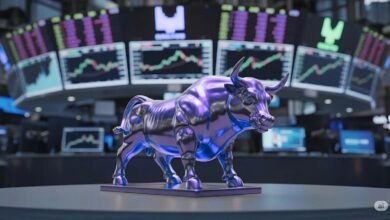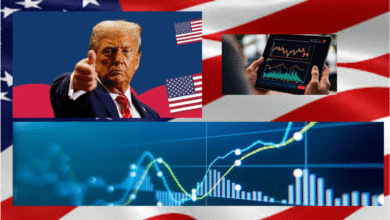Wall Street Holds Steady as Disney, McDonald’s Earnings Shine and Apple Surges on $100 Billion US Investment
Markets React Positively to Strong Corporate Results and Fed Support Amid Trade Tensions and Tariff Deadline

Wall Street opened on a steady footing Wednesday, as investors welcomed better-than-expected earnings from major U.S. corporations including The Walt Disney Company, McDonald’s, and Apple. Despite lingering uncertainty over looming tariff deadlines and ongoing trade negotiations, the major U.S. benchmark indices — the Dow Jones Industrial Average, the Nasdaq Composite, and the S&P 500 — all remained relatively flat in early trading, indicating growing market resilience in the face of geopolitical pressures.
Corporate earnings and economic policy have become the twin engines driving investor sentiment, with many now betting that strong business fundamentals and supportive monetary policy could outweigh concerns tied to global trade dynamics — at least in the short term.
U.S. Markets Open Flat Amid Earnings Optimism
After a turbulent start to the year, U.S. markets have found new footing in recent weeks, bolstered by corporate profitability, consumer resilience, and Federal Reserve intervention. At the opening bell Wednesday:
- The Dow Jones Industrial Average was virtually unchanged
- The Nasdaq Composite held firm despite recent tech volatility
- The S&P 500 hovered near record levels, showing minimal movement
While headline index movements were muted, the story beneath the surface is more dynamic — especially for companies reporting blockbuster earnings.
Corporate Earnings Fuel Market Confidence
McDonald’s (NYSE: MCD): Strong Global Sales Push Stock Higher
McDonald’s, the world’s largest fast-food chain, impressed Wall Street with better-than-expected earnings and revenue, thanks in part to robust international same-store sales growth and increased digital orders. The company’s ability to maintain profit margins despite inflationary pressures was widely applauded by analysts.
- EPS: Beat estimates
- Revenue: Surpassed forecasts
- International Growth: Key contributor to outperformance
CEO comments emphasized ongoing investments in mobile ordering, delivery partnerships, and menu innovation as catalysts for continued growth.
The Walt Disney Company (NYSE: DIS): Streaming and Parks Power Strong Results
Disney shares rose modestly after the entertainment titan reported strong results, driven by:
- Growth in Disney+ and Hulu subscriptions
- Increased attendance at theme parks and resorts
- Record-breaking box office performance
Investors were particularly encouraged by Disney’s return to profitability in its theme park segment, after years of pandemic-related disruption. Analysts say Disney’s hybrid business model — part content giant, part physical entertainment powerhouse — makes it uniquely resilient in both digital and real-world environments.
Apple (NASDAQ: AAPL): Shares Jump 3% on $100 Billion US Investment News
One of the biggest early movers on Wednesday was Apple, whose shares climbed 3% following a White House announcement that the company would invest another $100 billion in the United States over the coming years.
Though Apple did not immediately release details, the move is expected to focus on:
- Expanding chip manufacturing capacity
- Increasing R&D spending in AI and machine learning
- Building new campuses and green energy infrastructure
This latest commitment comes as tech companies face increasing political pressure to onshore operations and reduce dependency on China, especially amid ongoing trade tensions.
Trade Talks Heat Up Ahead of Tariff Deadline
While corporate earnings have brightened the near-term outlook, markets are keeping a close eye on international trade negotiations. With the White House’s new round of tariffs scheduled to go into effect later this week, global governments are scrambling to strike last-minute deals with the administration of President Donald Trump.
The proposed tariffs are part of a wider U.S. strategy to rebalance trade relationships with China, the EU, and key emerging markets. If implemented, the new duties could:
- Disrupt global supply chains
- Raise input costs for U.S. manufacturers
- Stoke inflation in consumer goods
Despite the tensions, some analysts believe the market is already pricing in partial tariff impacts, and is more focused on domestic economic indicators and corporate profitability.
Fed Rate Cut Provides Economic Cushion
In another key development this week, the Federal Reserve implemented a 25 basis point rate cut, signaling continued commitment to supporting the U.S. economy amid global uncertainty.
Fed Chair Jerome Powell noted that while the labor market remains strong and inflation is under control, the rate cut was warranted due to:
- Ongoing trade disruptions
- Slowing global growth
- Persistent risk aversion among investors
This dovish stance from the Fed provides a much-needed safety net for equity markets and has been welcomed by Wall Street as a green light to maintain equity exposure, especially in growth sectors like technology, consumer discretionary, and financials.
Analyst Reactions and Market Commentary
Market strategists are pointing to a “tug of war” scenario: strong earnings and a supportive Fed on one side, geopolitical uncertainty and trade risks on the other.
“Right now, the fundamentals are strong enough to keep the market steady,” said Daniel Morris, Chief Market Strategist at EquityFirst Advisors. “But the longer trade tensions linger, the more difficult it will be to justify high valuations in sectors like tech.”
Others note that corporate America appears more agile than expected, able to adapt quickly to changing economic conditions and consumer behaviors.
What This Means for Investors
For both retail and institutional investors, today’s market reflects a moment of cautious optimism:
Positive Signals:
-
- Strong Q2 earnings across sectors
- New domestic investment from tech giants
- Fed rate cuts support borrowing and investment
- Risks to Monitor:
- Escalating trade wars and tariff implementation
- Potential inflation rebound
- Global economic slowdown
Analysts suggest diversifying portfolios, staying focused on fundamentally strong companies, and watching for volatility spikes as policy decisions unfold in the coming days.
What’s Next for Wall Street?
With earnings season in full swing and global trade decisions looming, the next few days could set the tone for the remainder of Q3. Key events to watch:
- U.S.–China trade talks and any last-minute tariff deals
- Upcoming earnings from Amazon, Microsoft, and JPMorgan Chase
- August jobs report and inflation data
- Federal Reserve commentary and potential future rate cuts
For now, investors appear to be giving the market the benefit of the doubt, as solid earnings and long-term investments in the U.S. economy offer reasons for cautious optimism.
Conclusion: Stability Amid Uncertainty
Wall Street is walking a tightrope — balancing solid corporate earnings, monetary easing, and geopolitical uncertainty. While Wednesday’s flat open may not signal a breakout rally, it reflects a market that is digesting risk in a measured and rational way.
The strength of American companies — from fast food to semiconductors to entertainment — continues to provide a foundation of stability, even as global trade dynamics introduce new variables.
The next few weeks will be critical, but if the current earnings trend continues, investors may have more reasons to cheer than fear.





